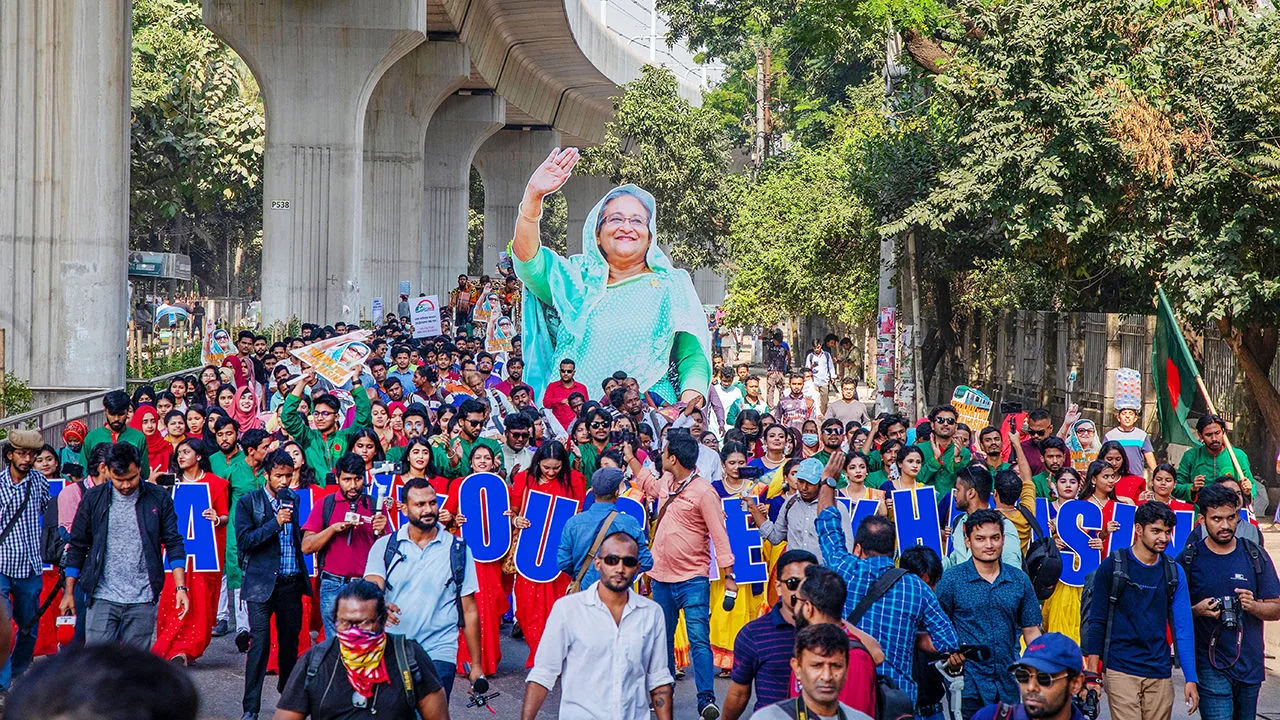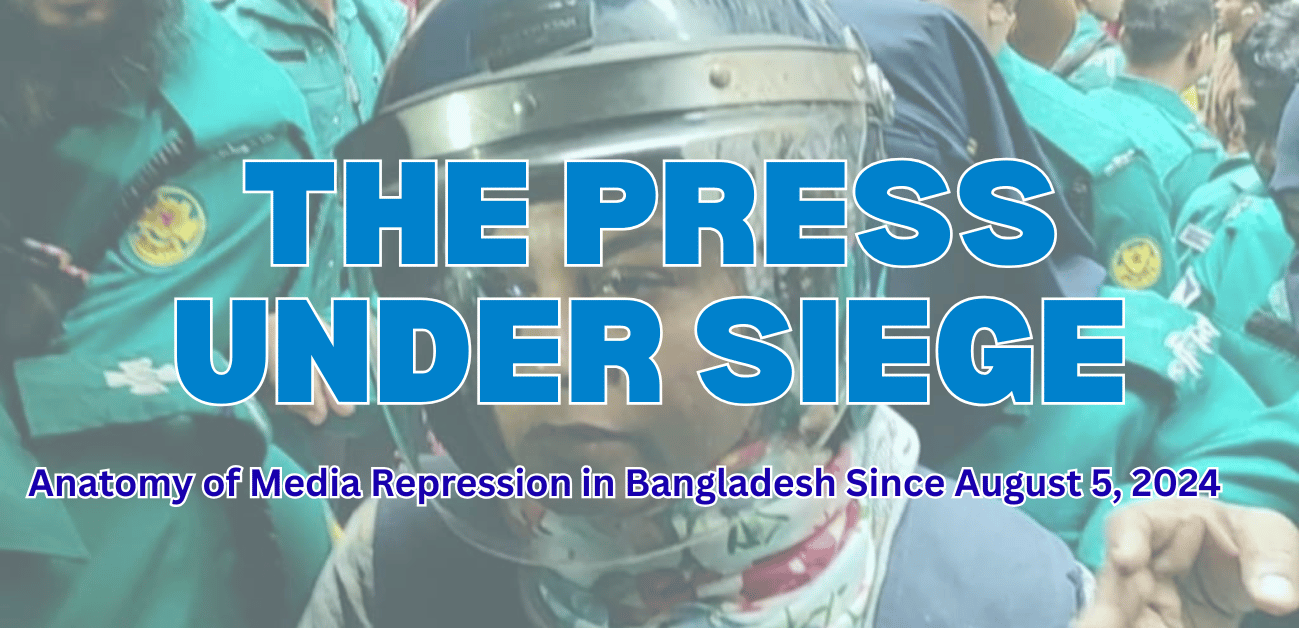Executive Summary Since the fall of Sheikh Hasina’s elected government on August 5, 2024, Bangladesh’s…

Sheikh Hasina’s Leadership: Developmental Democracy Or Fascism?
Introduction
The term “fascism” is often used as a political weapon rather than an analytical concept. In Bangladesh, Prime Minister Sheikh Hasina’s critics, particularly opposition parties, have labelled her rule (2009-2024) as fascist. However, based on theoretical and practical analysis, there’s no justification for this accusation. Historically, fascist regimes, such as Mussolini’s Italy, Hitler’s Germany, and Franco’s Spain, were built upon strict nationalism, militarization, suppression of civil liberties, and the centralization of autocratic rule.
Sheikh Hasina’s rule, while facing accusations of political dominance, has primarily been guided by economic modernization, democratic processes, institutional development, and regional diplomacy. Her leadership is more consistent with developmental democracy and competitive authoritarianism, rather than fascism. After analysis of the characteristics of fascism, it would be evident that Sheikh Hasina’s rule does not align with a fascist framework, and in some aspects, it is entirely contrary to fascist ideas. Instead, her tenure has been marked by economic growth, social progress, and political stability within a complex democratic structure. Our analysis will show that Sheikh Hasina’s rule and leadership from 2009 to 2024 is primarily a developmental democracy, with no theoretical basis whatsoever to be categorized as a fascist regime.
Core Characteristics and Theoretical Analysis of Fascism
To assess whether Sheikh Hasina’s rule is fascist, we must first understand the academic definition of fascism. American political scientist and historian Robert Paxton (2004) and British historian Roger Griffin (1991) have defined fascism by the following characteristics:
- Extreme Nationalism and Racial Supremacy: Fascist governments promote ideas of racial or religious superiority and implement them through aggressive expansionist policies.
- One-Party Rule and Suppression of Opposition: Fascist regimes eliminate political pluralism and often suppress opposition parties through violent means.
- Militarization and War-Centric Policy: Fascist countries use war and military expansion as political weapons.
- Economic Corporatism and State-Controlled Economy: The merging of the state and corporate institutions is used to suppress labour movements and civil society.
- Cult of Personality and Unconditional Loyalty: A fascist leader typically presents themselves as the saviour of the nation and demands absolute loyalty.
Absence of Fascist Ideology in Sheikh Hasina’s Rule
1. Political Pluralism and Presence of Opposition Parties
One of the defining characteristics of a fascist regime is the complete elimination of opposing political parties, typically through violent repression, coercion, or outright banning. Under Sheikh Hasina’s leadership, Bangladesh has maintained a multi-party democracy with regular elections, active opposition parties (though accusations of repressive behaviour exist), and a functioning civil society.
Opposition parties, particularly the Bangladesh Nationalist Party (BNP) and Jamaat-e-Islami, face legal and political challenges, but their existence and ability to contest elections contradict a fundamental characteristic of fascism. In fascist regimes, like those of Mussolini and Hitler, opposition parties were banned, dissidents were sent to concentration camps, and independent media were completely suppressed. However, in Bangladesh, there was considerable freedom of the press, with over 80 TV channels and 300+ newspapers actively operating, publishing criticisms of the government, and opposition parties holding various rallies and strongly criticizing the government.
Furthermore, the BNP’s strategy of boycotting elections and the resulting political instability, which largely stems from their failure to organize grassroots support, not from government repression, cannot be equated with the destruction of democracy under fascist rule. The strategic failures and organizational weaknesses of an opposition party are never equivalent to a systematic political extermination.
Instead, we observe that under Sheikh Hasina’s rule, several new political parties and alliances have been formed, further diversifying Bangladesh’s political landscape:
- Jatiya Oikya Front (National Unity Front): Formed in October 2018, this alliance included the Bangladesh Nationalist Party (BNP), Gono Forum, Jatiya Samajtantrik Dal (JSD), and Nagorik Oikya. The primary goal of this alliance was to challenge the government and campaign for free and fair elections.
- Gono Odhikar Parishad (Council for People’s Rights): Established in October 2021, this party was formed based on student movements, advocating for democratic reforms and social justice. Its emergence reflects the dynamism and political activism of Bangladesh’s civil society.
- Insaniyat Biplob Bangladesh (Humanity Revolution Bangladesh): Established in January 2010 and officially registered in May 2023, this party centers its politics on humanitarian values and has expanded its activities internationally.
The formation and activities of these new political parties and alliances clearly demonstrate the existence of political pluralism, which is contrary to the concept of fascist one-party rule.
2. Secularism and Absence of Ethno-Religious Supremacy
Fascism is typically characterized by extreme nationalism, ideas of ethnic or religious supremacy, and discriminatory policies towards minorities. From Hitler’s ethnic cleansing campaigns to Mussolini’s nationalist policies, classic fascist regimes implemented repressive measures against ethnic and religious groups to consolidate national identity.
However, Sheikh Hasina’s government has pursued a completely opposite policy, strengthening secularism and pluralism.
- Suppression of Religious Extremism: Her administration has rigorously controlled the influence of Islamist fundamentalist organizations like Hefazat-e-Islam and Jamaat-e-Islami, which has helped protect the foundation of secularism in Bangladesh.
- Humanitarian Approach to the Rohingya Refugee Crisis: Fascist governments typically believe in the expulsion or elimination of ethnic minorities. However, Sheikh Hasina provided shelter to nearly one million Rohingya refugees expelled from Myanmar, which demonstrates inclusive and humanitarian leadership.
- Protection of Religious Minorities: Her government has adopted various policies to ensure the safety of Hindu, Buddhist, and Christian communities, which contradicts the divisive and ethnically specific policies of fascist states.
All these measures prove that Sheikh Hasina’s leadership is not extremist nationalist or religiously divisive, but rather an example of secular, inclusive, and humanitarian leadership.
3. Economic Modernization vs. Corporate State Control
Fascist states typically follow a corporate economic model where the government merges with large industries to consolidate power, suppress labour movements, and direct the economy towards militarization.
Sheikh Hasina’s economic policy has been market-based and development-oriented, which is more consistent with Developmental Democracy rather than a state-controlled fascist economic model. During her tenure, Bangladesh achieved the following economic successes:
- Consistent GDP Growth: Bangladesh has maintained an average annual GDP growth of 6-7%, which has elevated the country from a low-income to a middle-income nation. (World Bank, 2023)
- Infrastructural Development: The implementation of various mega-projects, including the Padma Bridge, Metro Rail, and Rooppur Nuclear Power Plant, demonstrates that her objective was economic development, not political dominance.
- Poverty Reduction: The poverty rate decreased from 31.5% in 2009 to 18.7% in 2023 (Bangladesh Bureau of Statistics, 2023). Additionally, per capita income has increased, $842 (2009) to $2738 (2023), reflecting inclusive economic policies.
Furthermore, Bangladesh’s private sector has expanded significantly, especially the Ready-Made Garments (RMG) industry, which grew from $12 billion in 2010 to $46 billion in 2023 (Bangladesh Bank, 2023).
In a fascist economy, the state establishes full control over industries and suppresses competition. However, Sheikh Hasina’s government has encouraged private sector development, foreign investment, and a free market economy, which is the opposite of a fascist economic structure.
4. Absence of Militarization and Abandonment of Expansionist Policies
Fascist regimes typically try to establish political legitimacy through military expansionism and war. Mussolini’s Italy attempted to conquer Africa, Hitler’s Germany initiated World War II, and Japan’s fascist leadership pursued imperialist aggression in the Pacific.
However, Sheikh Hasina’s foreign policy has followed an opposite path, based on diplomacy, commercial partnerships, and regional cooperation, rather than militarization. During her tenure, Bangladesh adopted the following strategies:
- Strengthening International Diplomatic Relations: Bangladesh has improved bilateral relations with India, China, the United States, and Russia, but has never engaged in military conflict or adopted an aggressive stance.
- Peaceful Resolution of Border Disputes: Bangladesh resolved maritime boundary disputes in the Bay of Bengal through the International Court of Arbitration, an example of diplomatic resolution without war or military intervention.
- Refraining from Military Intervention: Under Sheikh Hasina’s rule, Bangladesh has not engaged in any military aggression or posed a threat to the sovereignty of neighbouring countries, which is entirely contrary to fascist expansionist policies.
Sheikh Hasina’s demilitarization policy, commitment to regional stability, and peace-based foreign policy demonstrate that her rule has not followed a militaristic or fascist war policy.
5. Institutional Governance, Not Autocratic Dictatorship
In a fascist regime, there is an all-powerful leader whose authority operates without any checks. Typically, in such regimes, government institutions are destroyed or brought under personal rule. However, while Sheikh Hasina is a strong leader, she has not transformed Bangladesh’s parliamentary democracy into a personalized dictatorship.
The judiciary, administration, and parliament have functioned effectively, although there are debates about the influence of executive power. This influence of executive power is not personalistic; in many advanced democratic countries, both parliamentary and presidential, the chief executive can be seen exercising extensive power.
Freedom of the press was maintained, although there were occasional accusations of government control. Many new media outlets have been established, and they have criticized Sheikh Hasina’s government without hindrance.
An independent business sector and civil society have remained active, which is contrary to the strict authoritarian control of a fascist state.
While there are accusations of media control and political influence, it is by no means completely repressive or akin to a fascist state. During Sheikh Hasina’s rule, opposing voices were strongly heard in Bangladesh’s educational institutions, media, and civil society. Therefore, this proves that Sheikh Hasina’s governance structure lies more within the framework of institutional democracy than fascist autocracy.
Conclusion: Developmental Democracy, Not Fascism
Strong leadership does not equate to fascism. While Sheikh Hasina’s rule demonstrated strong leadership, it is not consistent with the core principles of fascism. Instead, her governance has been characterized by economic modernization, regional diplomacy, electoral processes, and institutional development. Analyzing her rule solely through the lens of European fascism, without considering the realities of Bangladesh’s political culture, would be misleading.
The term ‘fascist’ is often used in political discourse to discredit leaders, but theoretical and practical analysis clearly show that Sheikh Hasina’s rule is completely different from fascist states. Her leadership can be classified under Developmental Democracy, where state-led economic growth and efforts to maintain stability are preserved within a democratic framework.
Therefore, labelling Sheikh Hasina as a fascist is theoretically and practically unfounded. Instead, her rule should be evaluated in light of Bangladesh’s unique political evolution and the social and economic development achieved under her leadership.
References:
Paxton, Robert O., Ernst Jünger, Benito Mussolini, and Art Spiegelman. “What is Fascism?” The Anatomy of Fascism (New York: Alfred A. Knopf) (2004).
Griffin, Roger. The nature of fascism. Routledge, 2013.
The Authors are Associate Professors of a University, PhD Researchers




Comments (0)